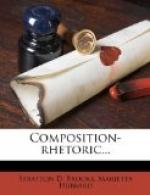This faculty of organization shows itself in what we technically name structure; and logical and rhetorical structure may be studied at their very best in his work. His essays are perfect units, made up of many parts, systems within systems, that play together without clog or friction. You can take them apart like a watch and put them together again. But try to rearrange the parts and the mechanism is spoiled. Each essay has its subdivisions, which in turn are groups of paragraphs. And each paragraph is a unit. Take the first paragraph of the essay on Milton: the word manuscript appears in the first sentence, and it reappears in the last; clearly the paragraph deals with a single very definite topic. And so with all. Of course the unity manifests itself in a hundred ways, but it is rarely wanting. Most frequently it takes the form of an expansion of a topic given in the first sentence, or a preparation for a topic to be announced only in the last. These initial and final sentences— often in themselves both aphoristic and memorable—serve to mark with the utmost clearness the different stages in the progress of the essay.
Illustration is of more incidental service, but as used by Macaulay becomes highly organic. For his illustrations are not farfetched or laboriously worked out. They seem to be of one piece with his story or his argument. His mind was quick to detect resemblances and analogies. He was ready with a comparison for everything, sometimes with half a dozen. For example, Addison’s essays, he has occasion to say, were different every day of the week, and yet, to his mind, each day like something—like Horace, like Lucian, like the “Tales of Scheherezade.” He draws long comparisons between Walpole and Townshend, between Congreve and Wycherley, between Essex and Villiers, between the fall of the Carlovingians and the fall of the Moguls. He follows up a general statement with swarms of instances. Have historians been given to exaggerating the villainy of Machiavelli? Macaulay can name you half a dozen who did so. Did the writers of Charles’s faction delight in making their opponents appear contemptible? “They have told us that Pym broke down in a speech, that Ireton had his nose pulled by Hollis, that the




